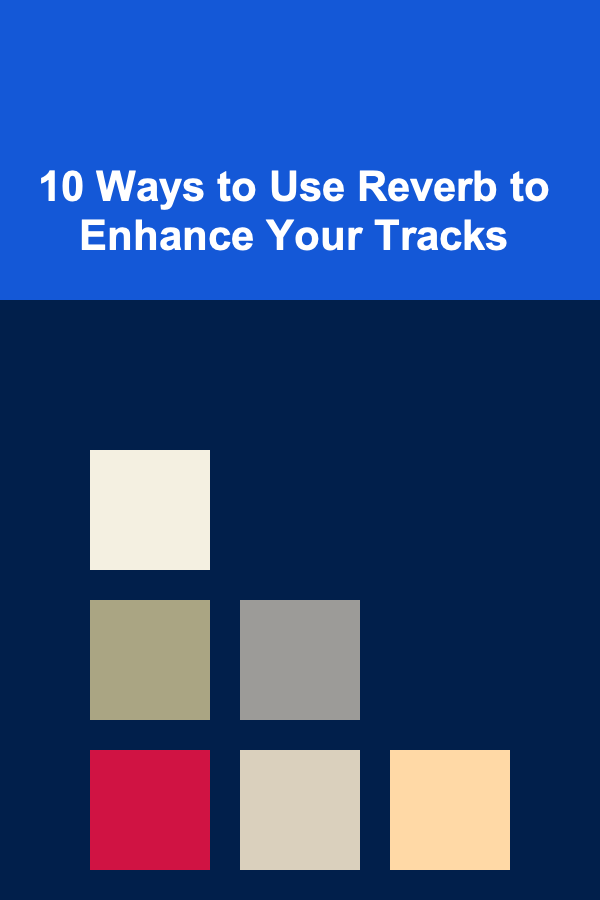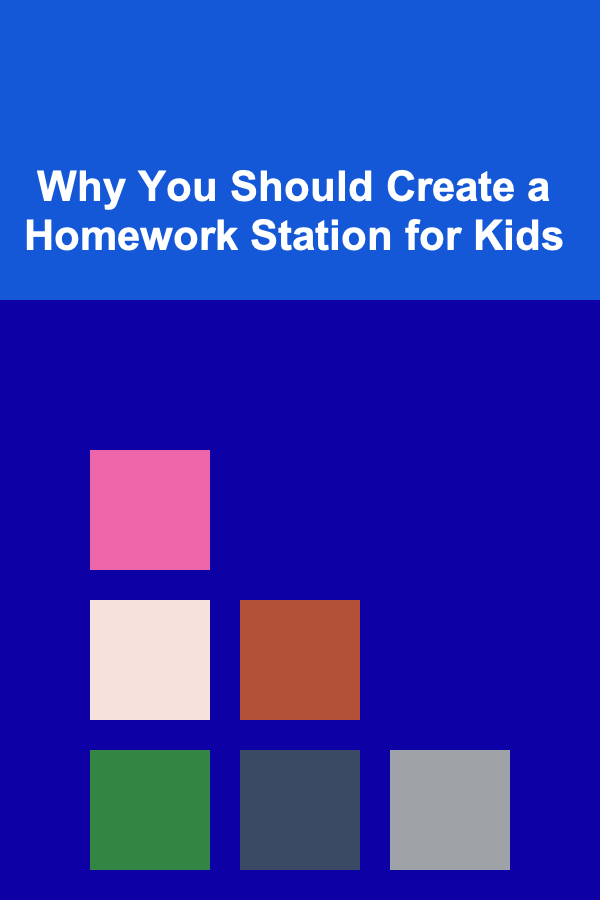
10 Ways to Use Reverb to Enhance Your Tracks
ebook include PDF & Audio bundle (Micro Guide)
$12.99$5.99
Limited Time Offer! Order within the next:

Reverb is an essential effect in modern music production. It has the power to shape the sound of a track, creating depth, space, and atmosphere. When used creatively, reverb can transform a simple recording into something that feels rich, immersive, and polished. Whether you're working in a home studio or a professional setting, understanding how to use reverb effectively is crucial.
In this article, we will explore 10 different ways to use reverb to enhance your tracks, providing you with practical tips and insights that will elevate your production skills.
Creating Depth and Space in a Mix
Reverb is one of the most effective ways to add a sense of depth and space to a mix. By applying reverb to different tracks in varying amounts, you can simulate the effect of sound reflecting off surfaces, making the sound feel as if it's taking place in a particular environment.
For instance, you can apply a long reverb to a vocal track to give it the sensation of being in a large hall or church, or use a short, tight reverb on drums to make them feel close and punchy. The key to using reverb for depth is subtlety; too much reverb can muddy the mix, while the right amount will provide a sense of spatial separation between elements.
Tip:
Use reverb in conjunction with EQ to control its effect. Cutting some of the low frequencies from the reverb can help prevent the track from feeling too distant or muddy.
Enhancing the Vocal Presence
Vocal tracks often benefit from reverb because it can make them sound more natural, smoother, and immersive. However, the way you apply reverb to vocals can dramatically affect the emotional tone of the track. For a more intimate feel, a small amount of reverb can help the vocals sit nicely in the mix without overwhelming them.
For larger, more atmospheric tracks, you can use reverb to give the vocals a sense of space. A cathedral-style reverb with a long decay time can make a vocal performance sound grand, while a shorter room reverb can make vocals sound more intimate.
Tip:
Experiment with reverb and delay together for a richer vocal sound. Sometimes, the combination of both effects can help to create a more layered and spatially interesting vocal performance.
Reverb for Drums: Shaping the Room Sound
Drum sounds are key elements in most music genres, and reverb can be a powerful tool for shaping their character. While some styles of music prefer dry, tight drum sounds, others, such as rock, pop, or ambient music, benefit from adding reverb to create a sense of place.
For example, applying a small amount of room reverb to snare drums can make them sound like they're in a larger space, creating a sense of size without drowning the track in excessive effects. On the other hand, using longer reverb on toms or cymbals can help them blend together and create a more cohesive, expansive sound.
Tip:
Use reverb selectively on drums---less is often more. Adding too much reverb to drums, especially the kick, can make the mix feel disjointed and muddy.
Creating Ambience with Reverb
In many genres, ambient soundscapes are a vital part of the track's overall atmosphere. Reverb is perfect for creating ambient textures and spatial depth. For instance, adding reverb to background pads, synthesizers, or sound effects can give them a sense of location and airiness. This can help the track feel more alive and immersive.
By using reverb on ambient elements with a long decay time, you can simulate the feeling of open space, like an outdoor environment or a vast empty room. This technique is particularly effective in genres such as ambient, cinematic, or experimental music, where space and texture are crucial.
Tip:
Layer different types of reverbs (such as hall, plate, and room) to create a unique and complex ambient environment. This can enhance the track's atmosphere without making it feel overly processed.
Using Reverb for Special Effects
Reverb isn't just for creating realistic space; it can also be used creatively to add special effects and textures to your tracks. By automating the reverb settings, you can create dramatic transitions, build-ups, or other unique moments in your music.
For example, you might increase the reverb's decay time during a breakdown or drop to create a sense of "echoing out" before the next section kicks in. You can also use reverb on a particular sound effect or instrument to make it stand out and sound more otherworldly or surreal.
Tip:
Try automating the reverb mix to build tension or excitement during the arrangement. Gradually increasing the reverb on a particular element can create a moment of anticipation before a big hit or change in the track.
Using Reverb for Separation Between Elements
In busy mixes, reverb can help separate different elements, allowing them to "breathe" and be perceived more clearly. For example, if you have multiple layers of guitars, applying different types and amounts of reverb to each layer can help prevent them from clashing with one another. This can also apply to any other crowded sections, like vocals, synths, and percussion.
By giving each element its own reverb setting, you can create space for each sound to exist individually while still maintaining a sense of cohesion in the overall mix. This can also be used to create the illusion of a larger or smaller space for specific sounds.
Tip:
Use different reverb algorithms (room, hall, plate, etc.) on different instruments to make them sound like they're in different spaces. This can create a more dynamic, three-dimensional mix.
Reverb on the Drum Kit for Natural Sound
If you're working with live drums, applying a light amount of reverb to the entire kit can enhance its natural sound and add a cohesive feel to the mix. A small room reverb can make the drums sound as though they're in a real room, without overly washing them out or losing their impact. The key is to avoid excessive reverb on the kick or snare, which might make the drums sound too distant.
You can apply reverb to different parts of the kit to simulate how each element would sound in different parts of a room. For instance, you could apply a shorter reverb to the snare, a longer reverb to the toms, and a medium reverb to the cymbals for a well-rounded, natural sound.
Tip:
When applying reverb to a live drum kit, make sure to EQ the reverb to avoid muddiness, especially in the low end.
Using Pre-Delay for Clarity
Pre-delay is the time between the original sound and the reverb effect. By using a pre-delay, you can enhance the clarity of your track while still keeping the space and depth that reverb provides. For example, applying a pre-delay to the reverb on vocals or drums can allow the dry signal to come through more clearly before the reverb tail begins.
The pre-delay can help create a "sense of space" without making the track sound too distant. This technique works especially well on faster tempos or when you need to maintain clarity in a dense mix.
Tip:
Experiment with different pre-delay times for various instruments. Shorter pre-delay times can create a tight, more immediate feel, while longer pre-delays can create more room and air between the sound and the reverb tail.
Reverb for Sound Design and Texture
Sound design is an area where reverb can play a crucial role. By applying reverb to unconventional sources---such as field recordings, sound effects, or synthesized noises---you can create unique textures and tonalities that wouldn't exist without it. This can be a powerful way to create new sounds that add intrigue to your tracks.
For example, adding reverb to industrial sounds, glitchy effects, or white noise can transform them into atmospheric elements that blend seamlessly with your music. The longer the reverb, the more "alien" or surreal the texture becomes.
Tip:
Use reverb on non-traditional elements, such as contact microphones, field recordings, or synthesized atmospheres, to create unique textures that add depth to your sound design.
Using Reverb for Transitions Between Sections
Reverb can be a great tool for smooth transitions between different sections of a song, helping to glue parts of the track together. When switching from a verse to a chorus, for instance, increasing the reverb slightly can provide a natural sense of evolution and flow. Similarly, using reverb on an instrumental bridge can help it blend into the next part of the track.
By carefully automating the amount of reverb, you can help the track feel cohesive and dynamic, making each section transition seamlessly into the next.
Tip:
Use reverb as part of a build-up or breakdown to lead into a new section. This can create a sense of movement and anticipation, enhancing the overall arrangement.
Conclusion
Reverb is an incredibly versatile tool in music production that can be used in many different ways to enhance your tracks. From creating space and depth to shaping the sound of specific instruments, reverb is a key effect that can help you craft a polished, professional-sounding mix. By using reverb thoughtfully, experimenting with pre-delay, and layering different reverb types, you can create dynamic, immersive mixes that stand out in any genre.
Reading More From Our Other Websites
- [Home Cleaning 101] How to Clean Kitchen Drains Naturally: A Step-by-Step Guide to Unclogging and Freshening
- [Home Renovating 101] How to Use Lighting to Transform Your Home Renovation
- [Home Pet Care 101] How to Bathe a Dog: A Step-by-Step Guide for Pet Owners
- [Biking 101] How to Maintain Your Bike Tires for a Smooth and Safe Ride
- [Personal Financial Planning 101] How to Achieve Financial Freedom: Practical Strategies for Early Retirement
- [Home Lighting 101] How to Create the Perfect Lighting for Your Home's Exterior
- [Home Pet Care 101] How to Establish a Pet Bath Routine: Tips for a Clean and Comfortable Experience
- [Home Family Activity 101] How to Make a Family Time Capsule for Future Generations
- [Home Pet Care 101] How to Set Up a Cozy and Comfortable Pet Sleeping Area
- [Digital Decluttering Tip 101] From Chaos to Control: Building a Secure Password System in Simple Steps

Can You Make Money with Deep Learning? Here's What You Need to Know
Read More
How to Clean Your Electric Kettle for Better Performance
Read More
How to Create a Checklist for Hosting Virtual Book Club Meetings
Read More
What Inspirational Quotes Can Motivate You to Stay Organized?
Read More
Why You Should Create a Homework Station for Kids
Read More
How to Use AI to Enhance Your Blogging Workflow
Read MoreOther Products

Can You Make Money with Deep Learning? Here's What You Need to Know
Read More
How to Clean Your Electric Kettle for Better Performance
Read More
How to Create a Checklist for Hosting Virtual Book Club Meetings
Read More
What Inspirational Quotes Can Motivate You to Stay Organized?
Read More
Why You Should Create a Homework Station for Kids
Read More